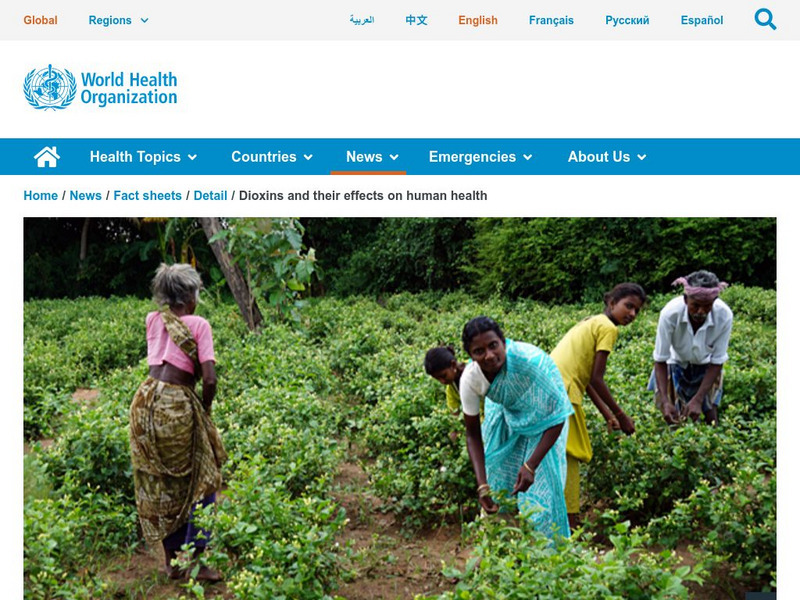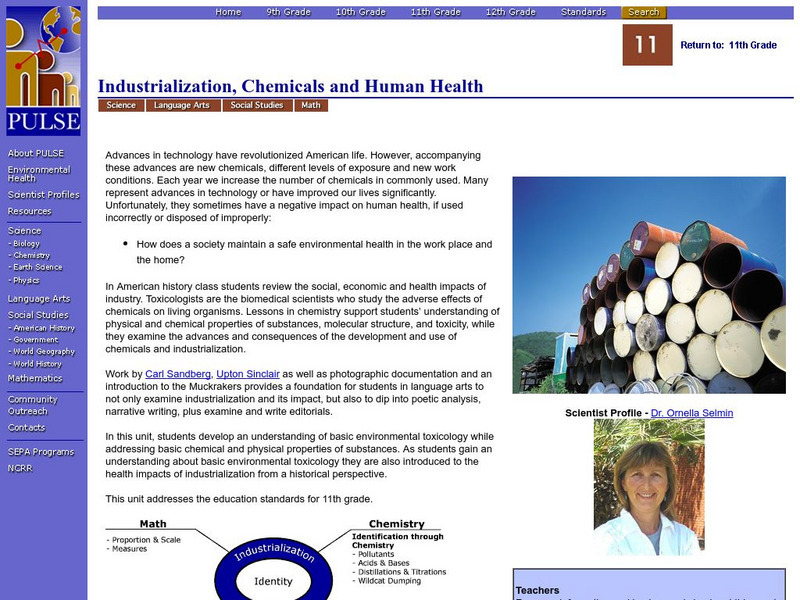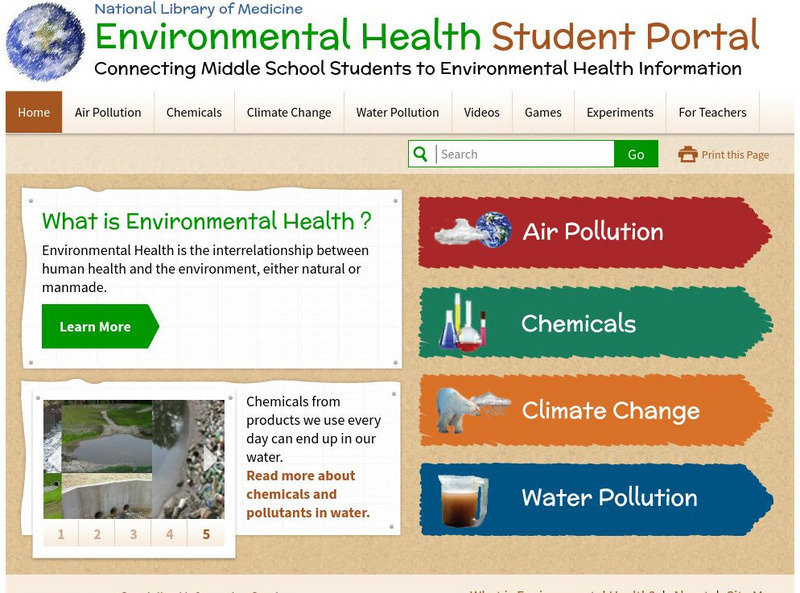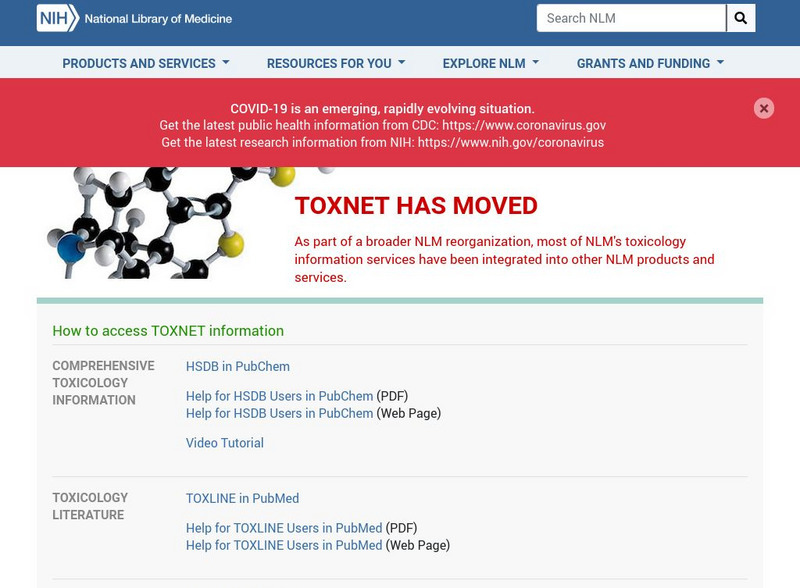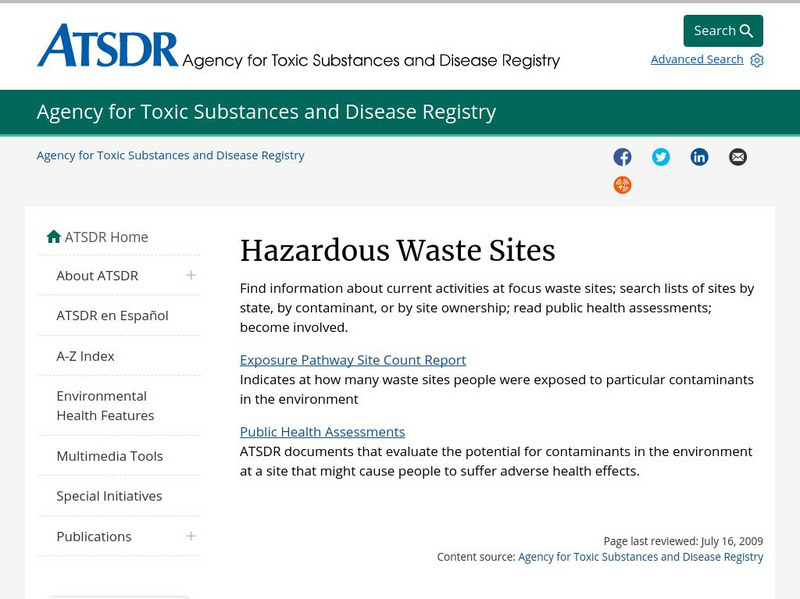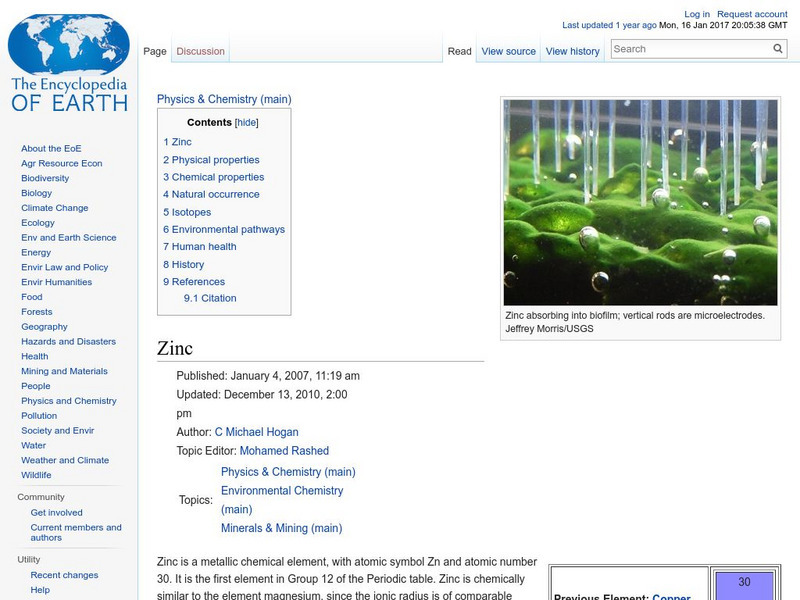World Health Organization
World Health Organization: Dioxins and Their Effects on Human Health
The World Health Organization answers questions relating to dioxins in our environment. Learn what dioxins are, how they effect our health and what is being done about possible contamination of the food supply.
University of Arizona
Pulse: Industrialization, Chemicals and Human Health
While students gain an understand of basic environmental toxicology, they explore the health impacts of industrialization on society in these lessons. This is a cross curricular unit that addresses standards for eleventh grade in math,...
National Institutes of Health
National Library of Medicine: Environmental Health Student Portal
An entire site of resources specifically for environmental science and how it is linked to human health. Topics include water pollution, air pollution, climate change, and chemicals.
PBS
Pbs Learning Media: Environmental Public Health: How Does Your Environment Affect Your Health?
In this self-paced lesson, students learn how environmental factors affect the health of living things, including humans.
National Institutes of Health
National Institutes of Health: Household Products Database
Everything you ever wanted to know about every household product available, from battery disposal to detergent and glue.
US Environmental Protection Agency
Epa: Learn the Issues: Chemicals & Toxics
This site provides real-world issues as well as the scientific research and technology used to support the EPA's mission to protect human health and safeguard the natural environment.
PBS
Now With Bill Moyers: Kids and Chemicals: Facts and Laws
Investigate synthetic chemicals that may be found in one's environment, and consider how toxic synthetic chemicals may affect people differently. Reflect on alternatives to toxic home-use products, and evaluate the risks and benefits.
National Institutes of Health
National Library of Medicine: Tox Town: Environmental Health Concerns
Learn about toxic chemicals and the environmental healths risks you might encounter everyday in familiar places. Select neighborhoods or locations to discover what chemicals might be found there and the health risks associated with each.
PBS
Pbs Teachers:hazardous Chemicals in Your Neighborhood
Identify hazardous chemicals and their effect on human health and the environment. Explain the importance of cleaning up hazardous waste, and identify facilities and agencies that deal with hazardous chemicals.
University of Arizona
University of Arizona: The Biology Project: Chemicals and Human Health
The University of Arizona's Biology Project provides background information on toxic materials and the body's responses as well as interactive tutorials with assessment questions and an activity in which students can actually acquire and...
Massachusetts Institute of Technology
Mit: Open Course Ware: Chemicals in the Environment: Toxicology and Public Health
A college course featuring instructor's notes and case studies about the relationship between exposure to environmental chemicals and human diseases.
Centers for Disease Control and Prevention
Centers for Disease Control: Antimony: Atsdr Fact Sheet
This resource describes the chemical element antimony (chemical symbol Sb) and gives detailed information about its effects on human health and the environment.
BioEd Online
Bio Ed Online: Can Nutrients in Water Cause Harm?
Many different kinds of organisms live in water. Excess nutrients can cause over-abundant growth of some organisms living in water and non-point source pollution is a major threat to water supplies in the United States. In this...
NOAA
Noaa: Environmental Restoration
Your questions answered about environmental restoration after chemical accidents. A large section is dedicated to oil spills and how they contaminate the earth. Great information.
US Geological Survey
Usgs: Effects of Human Activities
This site reviews the effects of agricultural development, urban and industrial development, drainage of the land surface, modifications to river valleys, and modifications to the atmosphere have on ground water and surface water.
National Institutes of Health
United States National Library of Medicine
Home page of United States Department of Health and Human Services and the National Library of Medicine. All medical information contained in the Medline search engine comes from this, one of the world's largest medical libraries.
US Environmental Protection Agency
Epa: Assessing Health Risks From Pesticides
This site provides information about the active ingredients registered as pesticides. Site discusses toxicology, exposure, dose-response and risk characterization.
Centers for Disease Control and Prevention
Centers for Disease Control: Atsdr: Superfund Hazardous Waste Sites
Extremely detailed look at the dangers associated with the hazardous and solid waste sites in the U.S.
Other
Household Hazardous Waste
This site contains great information about a number of household hazardous wastes and suggested methods of disposal.
Other
Environment Canada: What Is Acid Rain?
A thorough explanation of acid rain with a focus on the following topics: what is acid rain, the pH scale measures acidity, what does acid rain do, and what can I do about acid rain.
Encyclopedia of Earth
Encyclopedia of Earth: Zinc
Information about the element, Zinc, atomic number 30. Covers physical and chemical properties, how abundant it is on the Earth, where it occurs, isotopes, zinc in the environment, its role in human health, and the history of its use in...
Other
John Hopkins: Researcher Dispels Myth of Dioxins and Water Bottles
This resource provides information about dioxins, water bottles, and their effects on humans.
Other
Arctic Natives, Wildlife Threatened by Pollution
An article about the industrial chemicals and pesticides that are threatening life in the Arctic. Explains which species are more vulnerable to the pollutants.
US Geological Survey
Usgs: National Water Quality Assessment Program
Use this website to find out about water quality issues anywhere in the U.S.A. where water studies have been conducted by the U.S. Geological Survey.
